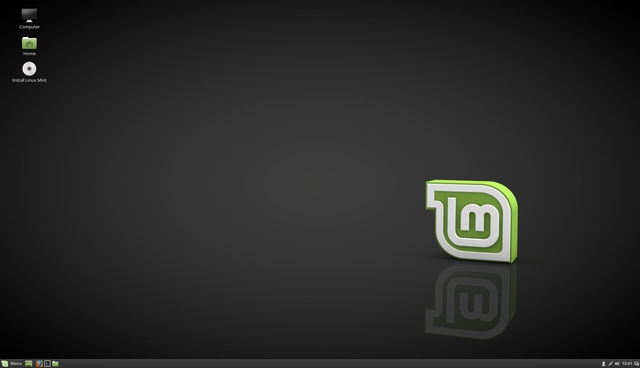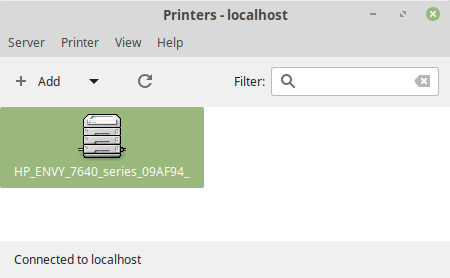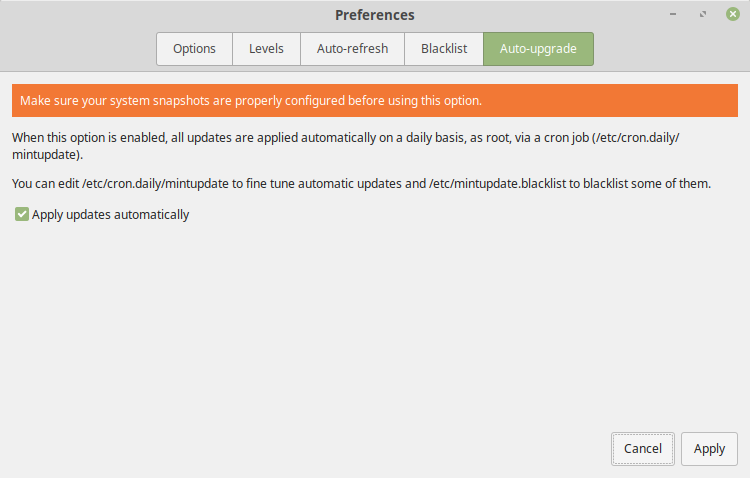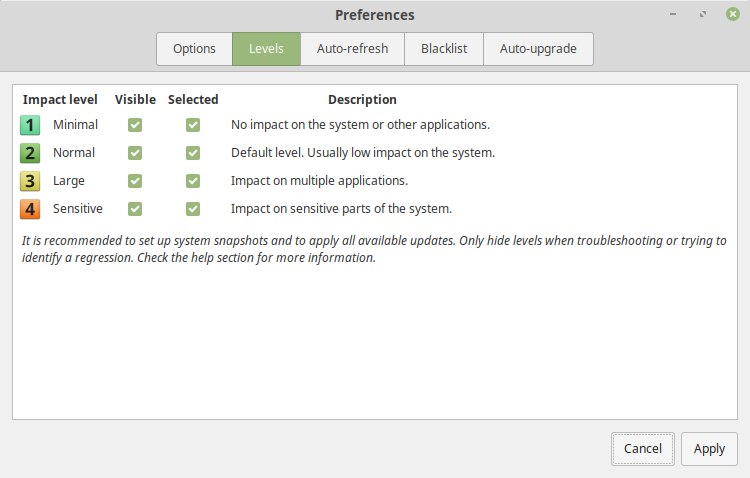I’ve been a big fan of Linux Mint for years. Of all the Linux distributions I’ve tried, it has the most “Windows-like” feel to it. It’s also one of the more complete distros, with most of the needed components pre-installed. Since I first tried it years ago, I’ve run it on various NUCs for various purposes. I even dabbled in using it as the OS for a home theater system back in the day by combining it with Myth TV. Boy was that an adventure.
One thing I haven’t done is run it on the NUC my wife uses. This is primarily because she’s been comfortable with Windows. She’s not a techie (one of her go-to phrases when something doesn’t work is “technology hates me!”), and once she’s got the hang of something on the computer, she’s not big on changing it. So I’ve kept that NUC a Windows 10-based system for her.
Linux Mint 19.1 (Tessa) is as close to Windows as I’ve come without using Windows. It’s easy to install, comes with all the bells and whistles you’d expect in a desktop environment, and is, in my opinion, an improvement over Windows in some areas. So when I looked at the latest release, version 19.1 (with the Cinnamon GUI), it was so polished, user-friendly, and complete that I thought it might be time to try it out on my wife’s NUC. She is, after all, my ultimate benchmark for practicality and usability. If she tells me a feature is a waste of time, it more than likely is. If she says something’s a game-changer, it’s time for me to start buying stock in that company (I’m looking at you, Caavo).
When it comes to computing her needs are fairly simple. Most of what she uses the NUC for can be accomplished in a web browser or a word processor. Still, I wanted to get the Mint experience as close to Windows as possible for her. And I also regularly use the system for writing and video editing, so I wanted something that would cover my needs as well.
The Hardware
These days her system is a Dawson Canyon i5 with 16GB of RAM and a 512GB m.2 SSD.

It’s plenty powerful enough for everything she does in Windows. Mint’s requirements (1GB RAM (2GB recommended), 15GB of disk space (20GB recommended), 1024×768 resolution) are drastically less than Windows, so there were no concerns there. The hardware would run just fine as is. The only change for me was swapping in a new SSD, so I’d still have the Windows installation as a backup
Installation-Try Before You “Buy”
Installing Mint is pretty straight forward; download the latest image from their site, use an imaging utility to make yourself a bootable flash drive, and boot the system to it. Here is one area where I prefer Mint (and most flavors of Linux) over Windows. Instead of going straight into the installation wizard like Windows does, Mint boots to a “live” desktop environment. This gives you a chance to poke around and try it out without actually installing it.

Once you’re sure you want to install, you click on the installer and answer a simple series of questions. The questions are put forth in an easy to understand way, and most answers are pre-populated to help you. Also, unlike Windows it’s not going to ask you how much of your privacy you want to give up. With any version of Linux, security is the rule rather than the exception. For example, the Windows installer will happily let you set a blank password. Not so with Linux.
Mint had drivers built in for all of my NUC’s hardware. Your mileage may vary, but in my case everything worked out of the box.
Mint’s interface…at least the Cinnamon version…resembles Windows 7 more than Windows 10. If you’re like me (or my wife), that’s a good thing. In my opinion, Windows’ interface peaked with 7. After that Microsoft got all cute with live tiles and started taking away from the functionality in the name of making something look shiny & new. Mint sticks with a simple, practical, and most importantly functional menu system.
I went through the wizard and let the installer do its thing. When it was done, I rebooted and was happily looking at the Mint desktop. I wasn’t quite done, though. Since I was using an SSD, I had a few tweaks to apply to be sure my SSD had a good long life.
SSD Modifications
I found a great how to article that combines all the best tweaks and tips for running Linux Mint on an SSD. I like this particular article because it not only walks you through how to apply each tweak, it does a great job of explaining why you should do it. It also explains why many tweaks from the past are no longer necessary. It’s easy to follow and lays everything out in order. These tweaks should extend the life of your SSD by minimizing writes to it.
Incidentally, the browser tweaks recommended in the article aren’t just for Linux. You can make the same changes for Chrome and Firefox in Windows, and it should help your SSD live longer. Browsers tend to do a lot of writing to your storage, and it helps to minimize that wherever possible.
Suspend and Wireless Keyboards
One thing I came across after I initially posted was that my Logitech keyboard/mouse wouldn’t wake the system from sleep. This is apparently an Ubuntu thing. I did some online research and came across the solution here. This is a miss for Mint, as wake from suspend with my wireless keyboard/mouse works automatically in Windows. Still, a relatively easy fix.
Printing
On the other hand, Mint surprised me when it came to my HP Envy all-in-one printer. I’d forgotten all about setting up the printer when I made the switch. It’s configured on my wireless network. A couple of days later I was at work and my wife was home printing recipes. This surprised me, since I hadn’t installed printer drivers. When I got home I asked her if she’d had to install anything or if Mint had prompted her. No, she said, it just printed. I checked, and sure enough, Mint had detected the printer and set it up:

I decided to check the scanning capability, and sure enough:

Contrast this to Windows, where I had to scan for and install drivers for the printer to work. Mint wins this round for sure!
Better than Windows
When I say Mint is better than Windows in some areas, it’s mainly due to the simplicity of how things are handled. Mint’s software management tool makes easy work of searching through a large database of applications to find what you need, and installing is as simple as clicking “Install”. It just feels cleaner than the Windows app store.
Similarly, Mint’s system update manager is more flexible, allowing you to easily select how and when updates are installed. It also includes a blacklist, so you can tell it to ignore certain applications when checking for updates.
Web Browsers
When I first mentioned to my wife I wanted to try this on her system, her first question was “what about all of my saved logins?”. Fortunately, most modern browsers have an option to synchronize your history, bookmarks, and logins by logging in with an account. Chrome’s method can be found here, and you can see Firefox’s sync options here. Mint includes Firefox by default, but I also wanted the option to use Chrome, so I installed Chromium through the software manager. History, bookmarks, and logins for both browsers came over easily by using the sync options.
I’m happy to report the browsing experience is pretty much identical. About the only thing I’ve noticed in either of the browsers is a slight difference in fonts, but after a few minutes I forgot about that entirely.
Video Editing
Ok, confession time: I’ve been using Windows Movie Maker for years. Anyone who edits videos on a regular basis probably just did a spit take. Sorry about that. I know it’s an old (very old) program with almost no features. It’s so outdated in fact, that Microsoft doesn’t include it with Windows anymore. But it was my first editing tool, and whenever I found myself wanting to make a quick or simple video, I fell back on Movie Maker.
Obviously Movie Maker doesn’t exist in Linux, so I decided to give Mint’s recommendation, OpenShot, a whirl.
So far, it’s worlds better than Movie Maker, and doesn’t have nearly the learning curve of Resolve. Don’t get me wrong, I love Resolve. It’s just that sometimes you need a simpler tool to get things done quickly.

Blue Light Filter
My wife is big on blue light filters on our devices. The sleeps better now that she’s not constantly bombarded with harsh light from her devices. On this NUC we’ve been using f.lux. While I could’ve just install the Linux version, I opted to use the built-in Redshift, as it performs the same function and doesn’t require any extra work on my part.
Office Applications
I convinced my wife years ago to make the switch to Libreoffice.

Office was expensive, and at the time was moving to a subscription model. With a number of free, open source options out there that covered every feature we’d ever used, it just didn’t make sense to pay Microsoft for the privilege of writing a letter or making a spreadsheet. Turns out that was a good move, since Libreoffice is included with Mint. Nothing new here. Everything works exactly the same. Nice!
Gaming
I’m not a gamer. My wife is even less of one, showing a general disdain for that form of entertainment. That’s a good thing, because that’s one area where Linux falls short. Most PC games are made for Windows or Mac, not Linux. Yes, there are ways to set up Wine to allow Windows games to work, but it’s not a cake walk to get things working. Still, when I checked out the games section of Mint’s software manager, I was surprised to see there are quite a few games to choose from.

They’re lesser-known, open source games, but some look pretty darned good. Everything from first person shooters to racing games. For the casual gamer, there’s some fun to be had.

If you run Windows games like The Sims, Call of Duty, or whatever you crazy kids are playing these days, Mint might be a tougher sell. It’s possible to get them working, but it takes a bit more effort.
Other Applications
I’m the first to admit moving to Linux on this system was easy, in part because of my wife’s simple needs. Nothing hardcore or unusual here, just web browsing and office work.

For people with other specific needs, I still say it’s worth while to look into Mint. You may find that there’s a Linux version of the application you’re using. Or you may find there’s Linux app that does exactly the same thing.
If you’re willing to invest a little time learning something new, you might even find you like the Linux version better. The software manager’s catalog of applications is impressive, especially when you remember it’s all free.
If what you’re looking for isn’t in the software manager, you always have the vast Linux community to draw on for more software. Of course that means you may have to spend some time using a terminal window.

But I’m willing to bet if you’re looking to make the switch from Windows to Linux, running commands in a terminal window isn’t all that scary.
Even more fun, you could head over to Github and try your hand at compiling from source code. Ah…good times.

System Stability
One thing many Linux versions struggle with is stability. Depending on your skill level and what you’re trying to do, it’s possible (sometimes easy) to paint yourself into a corner. Install the wrong thing, tweak the wrong setting, and you could find yourself with a non-functional system. What’s more, Linux hasn’t always been as easy to bring back to life as Windows, so sometimes reinstalling from scratch was the best “fix”. Mint protects against this by encouraging you to set up the built-in system snapshot feature. Similar to Windows’ system restore, this feature makes copies of key system files on a regular schedule. That way, if you run into trouble, you can revert back to a happier time and move on with your life.



Conclusions
If you’ve been getting more and more fed up with Windows…the lax security, the privacy issues, the expense, etc…the latest version of Linux Mint just might be for you. Version 19.1 (code named “Tessa”) is a complete operating system. Fully featured, stable, functional, easy to install, and above all easy to use, Mint now offers a practical Windows alternative. It’s still Linux at heart, so it has all the robust capabilities of its Linux cousins. But it now comes packaged with usability features that give Windows users more reasons than ever to try something new. And did I mention it’s free?

Leave a comment